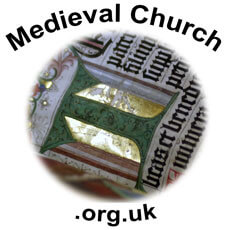John Huss (c.1372-1415)
Theology on the Web helps over 2.5 million people every year to find high quality theological resources that will help to equip them to serve God and to know Him better (2 Timothy 2:15). Like other websites that provide free services, it is dependent on donations to enable it to grow and develop and only 0.004% of visitors currently do so. If you would like to support this site, please use one of the options to the right of this message.
Synopsis
HUS, John, Bohemian reformer aimd martyr; b. in 1369 [according to Gillett, July 6, 1373], at Hussinetz, Bohemia, not far from the Bavariami line; d. at the stake, in Constance, Germany, July 6, 1415. Hus is an abbreviation of Hussinetz, and was used by him from 1396. His parents were Czechs, in comfortable circumstances. John studied at Prague, taking the degree of Bachelor of Theology in 1394, and Master of Arts 1396. In 1398 he delivered his first lectures, in 1401 was made dean of the philosophical faculty, and in 1403 rector of the university. He was a constant student of Wiclif’s works; and it is altogether likely, that in following the rule that a bachelor might only lecture upon the treatises of a Prague, Parisian, or Oxford master, Hus took up Wiclif. It is, at any rate, a noticeable coincidence that a manuscript containing five of Wiclif’s philosophical writings, preserved at Stockholm, was written by Hus in 1398.
In 1402 Hus was made pastor of the Bethlehem Church, which was founded (1301) to afford preaching for the Czechs. This position brought him into close contact with the common people, and stimulated him to a closer study of Scripture, as well as to the study of Wiclif’s theological works.
In the period from 1402 to 1410 Hais hoped to effect a religious reformation, with the aid of his ecclesiastical superiors. A disputation of the year 1403 led the authorities to forbid the promulgation of forty-five theses of Wiclif at the university; but, five years later, the interdiction was confirmed only to the extent that no one should give to them an heretical construction. Hus had the full confidence of the archbishop, Dr. Sbynko, and was appointed synodical preacher by him. At the opening of the provincial synod, he repeatedly took occasion to lay bare the errors, and denounce the sins, of the clergy. With two others, he was appointed by the archbishop to investigate the alleged miracles performed by the blood of Christ in the church at Wilsnack. They were pronounced a deception, and formed the occasion of Hus’s pamphlet, All the Blood of Christ is Glorified. He here bids Christians seek, not for signs and miracles, but search the Scriptures. But his relations to the archbishop changed, and in 1408 he was prohibited from exercising priestly functions within the diocese. The complete rupture was still to come.
In 1409 the University of Prague lost all its foreign students in consequence of a royal decree giving the Bohemian students three votes, the others only one. Leipzig University was founded; but in Prague an intense national spirit henceforth prevailed, which demanded ecclesiastical reforms. Hus was made rector, and was very popular, not only among the students, but at court. This freedom of inquiry excited the apprehension of the archbishop, who accused Hus to the Pope, apprising him, at the same time, of the wide prevalence of the doctrities of Wiclif. A papal bull of Dec. 20, 1409, prohibited the use of the English Reformer’s writings, and forbade preaching at places where the practice was not an ancient one. When the bull was announced (March 9, 1410), it aroused much opposition; but the archbishop executed it, burning on July 16 two hundred volumes of Wiclif, in spite of the adverse decision of the university. But Hus continued to preach, and the opposition increased. Verses lampooning the archbishop were sung on the streets, and even the lives of the priests menaced. Hus and his friends openly defended Wiclif’s writings at the university; while the archbishop, in a synodical edict, condemned them as heretical. The congregations at the Bethlehem Church grew to a vast size. Hus became bolder and more outspoken; and his audiences frequently showed their approval by applause. On March 15, 1411, he was excommunicated by the archbishop, and the city laid under an interdict. Both sentences were ignored; and the prelate was attempting to arrange a compromise, when death overtook him (Sept. 28).
In 1412 Hus and his sympathizers were roused to indignation by the preaching of a crusade against Naples, and of indulgences commanded by Pope John XXIII., and commended by the king. The university was divided; but in a public disputation (June 7, 1412) it was emphatically affirmed that neither Pope nor bishop had the right to draw the sword, for it was said to Peter, "Put up thy sword." As for indulgences, it was declared that not money, but true repentance, was the condition of forgiveness. The Pope does not know who are the elect, and they only can be saved; and the doctrine that he cannot err is blasphemous.
The populace sympathized with these utterances of the university, went in contemptuous procession in front of the archbishop’s palace, and made a bonfire of the papal bulls in the market-place. The king, Wenceslaus, forbade all popular insult to the Pope, and executed three young men who declared the indulgences to be a humbug. But Hus, attended by a number of students, took up their bodies, and buried them in the Bethlehem Church. Cardinal Peter of St. Angelo now determined to use more decisive measures, interdicted Hus’s place of residence, and threatened him with the civil ban. This was effective. At the king’s request he left the city (December, 1412), but not until he had written a work (the Appellatio), in which he appeals from the Roman curia to Christ the righteous Judge. He passed his exile at Kozihradek and Krakowetz, near Prague, preaching to large concourses of people, and writing his principal work, De Ecclesia, which only reproduced Wiclif’s De Ecclesia.
The religious agitation of Bohemia had become matter of European notoriety, and King Sigismund (of Hungary) decided that the case ought to be brought before the General Council about to be assembled at Constance. Hus cheerfully agreed to appear: three of the Bohemian nobility (at the king’s command) and two personal friends attended him, starting on their journey Oct. 11, 1414. The party was well received on the way, and arrived Nov. 3 at Constance. Four weeks afterwards the cardinals trumped up a charge of attempted flight, and faced him in confinement in a Dominican convent. A commission of three bishops made the preliminary investigation; the accused being denied a hearing. The articles of accusation were concerned principally with Hus’s errors about the Church. Only later was the distribution of both the elements at communion added.
The flight of John XXIII. rendered the work of his commission invalid; and the council appointed another, of four members, including d’Ailly. They were to sit in judgment upon Wiclif’s doctrines, as well as upon those of the Bohemian reformer, for both were set in the same key. On May 4, 1415, the council adopted their report so far as it concerned Wiclif, damning his person, his writings, and his doctrines.
On the 5th of June, Hus had his first public hearing in the Franciscan convent. The heretical articles extracted from his writings were read; but his attempt to vindicate them was interrupted by tumultuous cries. The second public hearing occurred on June 7. Sigismund himself was present. The question was upon his relation to Wiclif and his book on the Church. He boldly affirmed his esteem for the English Reformer as a pious man, but denied that he had adopted his views against transubstantiation. At the third session (June 8) he defended some of the articles drawn from his work on the Church.
The condemnation of Hus to the stake was a foregone conclusion. He himself knew it. His letters bear the stamp of approaching death. During the four weeks that followed, efforts were made to induce him to retract, but in vain. On Saturday, July 6, 1415, the sentence of the council was pronounced in the cathedral, condemning him as a heretic, and condemning his books to be burned. Hus fell on his knees, and, lifting up his hands, appealed to Heaven, and prayed for his enemies. Thereupon followed his degradation from the priestly office, and all cried out together, "Thy soul we deliver up to the Devil." Hus answered, "And I commend it to the holy Lord Jesus." Then a paper cap a yard high was placed on his head, with the writing, "Heresiarcha!" He was then led forth to the judgment-square, his neck bound by a chain to a stake. As the flames rose around him, he refused again to recant, and died singing, "Christ, thou Son of the living God, have mercy upon me." His ashes were thrown into the Rhine.
Valid ground for the sentence of condemnation, even according to the canons of that day, there was none. Hus denied holding to Wiclif’s views against transubstantiation, and his views upon the Church he founded upon Augustine. He then died because he based his reform of the Church upon conscience and Scripture, and not upon ecclesiastical authority. Judged by the canons of law then prevailing, Hus’s death was a judicial murder.
Hus regarded the Scriptures as an infallible authority and the supreme standard of conduct. The other main subject of his teaching was the nature of the true Church, which, with Wiclif, he defined to be the body of the elect. Church-membership or ecclesiastical dignities were no infallible sign of election. He approved the communion under both kinds to the laity, but did not oppose the doctrine of transubstantiation as was charged by the council.
John Hus was not an original, creative mind. As a thinker, he had neither speculative talent nor constructive faculty. Iii comparison with Wiclif, he is a moon with borrowed light. Nor was he by nature a strong character, twice hardened, and keen as steel. Rather was he a feeble and tender spirit, more sensitive than designed for heroic deed. But with his tenderness there was combined moral tenacity, indomitable constancy, and inflexible firmness. If we add to these characteristics his purity and humility, his manly fear of God, and tender conscientiousness, we have in Hus a man to love and admire. Seldom have the power of conscience and the imperial strength of a faith rooted in Christ asserted themselves in so commanding and heroic a manner.
G.V. Lechler, "Hus, John" Philip Schaff, ed., A Religious Encyclopaedia or Dictionary of Biblical, Historical, Doctrinal, and Practical Theology, 3rd edn, Vol. 2. Toronto, New York & London: Funk & Wagnalls Company, 1894. pp.1043-1045.
Bibliographies
Primary Sources
Secondary Sources
Related Subjects
 |
|
 |
|
 |





![Eustace John Kitts [1851-1925], Pope John the Twenty-Third and Master John Hus of Bohemia](images/books3/pope-john-the-twenty-third_kitts-tb.jpg) Eustace John Kitts [1851-1925], Pope John the Twenty-Third and Master John Hus of Bohemia. London: Constable and Company Ltd., 1910. Hbk. pp.446.
Eustace John Kitts [1851-1925], Pope John the Twenty-Third and Master John Hus of Bohemia. London: Constable and Company Ltd., 1910. Hbk. pp.446.  Malcolm D. Lambert, Medieval Heresy:
Popular Movements from the Gregorian Reform to the Reformation , 3rd edn.
Oxford: Blackwell Publishers, 2002. Pbk. Blackwell Publishers; ISBN:
0631222766. pp.284-326.
Malcolm D. Lambert, Medieval Heresy:
Popular Movements from the Gregorian Reform to the Reformation , 3rd edn.
Oxford: Blackwell Publishers, 2002. Pbk. Blackwell Publishers; ISBN:
0631222766. pp.284-326. F. Donald Logan, A History of the Church
in the Middle Ages. London & New York: Routledge, 2002. Pbk. ISBN:
0415132894. pp.326-328.
F. Donald Logan, A History of the Church
in the Middle Ages. London & New York: Routledge, 2002. Pbk. ISBN:
0415132894. pp.326-328.![Von Johann Loserth [1846-1936], Wiclif and Hus](images/books3/wiclif-and-hus_loserth-tb.jpg) Von Johann Loserth [1846-1936], Wiclif and Hus. London: Hodder & Stoughton, 1884. Hbk. pp.366.
Von Johann Loserth [1846-1936], Wiclif and Hus. London: Hodder & Stoughton, 1884. Hbk. pp.366.  W.N. Schwarze, John Hus: The Martyr of Bohemia. A Study of the Dawn of Protestantism. New York: Fleming H. Revell Company, 1915. Hbk. pp.152.
W.N. Schwarze, John Hus: The Martyr of Bohemia. A Study of the Dawn of Protestantism. New York: Fleming H. Revell Company, 1915. Hbk. pp.152. 


